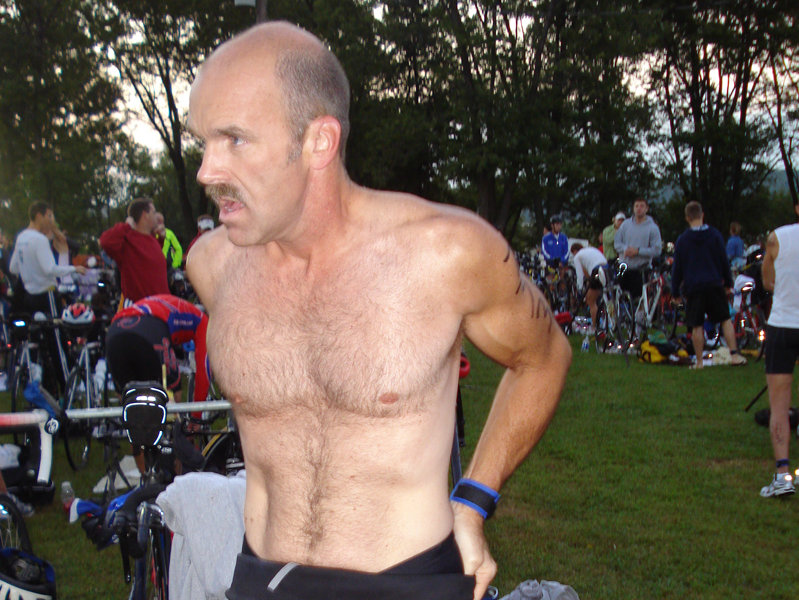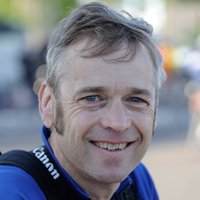With his doctor's stamp of approval, Karl Schultz will get back to competition this summer, racing against himself and the clock in triathlons and marathons.
It's a fortunate return, only possible because a year ago he beat the clock in his most important race, the one to save his brain.
Schultz, 51, has been a cyclist nearly all his life, since he got his first bike from Sears at age seven.
He's taken numerous spills and even flipped over the handle bars a half-dozen times. The crash on the Eisenbahn Trail one evening in late June 2011 didn't seem any more severe than the rest. His helmet spared his head and the soreness in his neck disappeared after three days.
Hidden in the recovery, however, was a tear in his vertebral artery caused by the whiplash of the fall. Over a month, the tear created a blood clot and started the clock ticking on Schultz's ability to compete, and his survival.
He first noticed a problem during an early-morning swim in the Kettle Moraine YMCA on June 25, 2011.
"I wasn't feeling super strong and was veering to the left in my lane," Schultz recalled. "I was moving fine, but I couldn't stay straight."
He struggled for a bit, then quit 10 laps into his planned 40-lap workout.
Keeping with the habit of an endurance athlete, he pressed on, wobbled to the locker room and dressed for work: director of clinical care services at Froedtert Health St. Joseph's Hospital – West Bend. Even with a medical background, he was more confused than troubled by the emerging symptoms, and drove the seven miles to his hospital.
A nurse who spied him walking toward the emergency room thought he might be drunk.
"I was thinking, 'I wonder if this is what a stroke is like?'"
Exactly.
Millions of brain cells in the lower part of his brain, an area that registers and controls sensation, were dying rapidly.
"Time is brain in that situation," Schultz said, repeating the mantra of stroke treatment.
According to National Stroke Association, strokes kill 130,000 people in the United States each year. They are the fourth leading cause of death.
In his experience as an age-group athlete, Schultz has enjoyed those days when training, strategy and execution combined for success. A similar meshing of access, communication and medical expertise played into his survival.
Doctors at St. Joseph's shared Schultz's lab reports and CT scans with the acute stroke team at Froedtert & Medical College of Wisconsin, a certified Stroke Center. With directions from Wauwatosa, the doctors in West Bend delivered t-PA, a clot-busting drug effective within 4 ½ hours of the stroke's onset.
"It was a really good collaboration with the two hospitals," said Dr. Osama Zaidat, an interventional neurologist at Froedtert. "You have something on board to help dissolve the clot, and that gives us the advantage in the treatment center. The stroke is easier to treat and to dissolve."
Schultz would later take pride in the collaboration that he helps oversee as an administrator, but in the Flight for Life helicopter flying him to Froedtert, his focus was much different.
"'What's my life going to be like?'" he remembered thinking. "Am I going to be in a wheelchair? Where are my clothes going? How will I get home from the hospital? If I am in a wheelchair, how am I going to get around and do my job?"
While Schultz's mind whirled with outcomes, doctors in the Froedtert stroke and neurovascular center threaded a catheter through his groin and delivered a dissolving agent directly into the clot in his neck.
Shortly after, he stood up, touched his nose, and held his arms out as if delivering a pizza. His arms stayed straight, free from the droop that had signaled the stroke to the doctors at St. Joseph's.
Schultz left the hospital four days later, and returned to work within two weeks.
He is now back to his workout routine and training for the Tri-ing for Children's Triathlon, the St. Jude Memphis Marathon, and hopefully, if he beats the clock in Memphis, the Boston Marathon.
"I'm definitely getting back in gear, with this great weather and long evenings we're having now," Schultz said. "It's funny ... now that I'm at the end of the treatment part, it is even more amazing that I have really no limits.
"It really is amazing to me that what has killed or maimed so many people was completely repaired in me. I'm so fortunate to detect it quickly, know what to do, and was more than a little lucky."
Lessons learned: Strokes are the leading cause of disability in the U.S., and Schultz beat the statistics by recovering fully.
Dr. Zaidat listed these important keys for a similar outcome: Quick recognition of symptoms – sudden numbness in the face, arm or leg; sudden confusion or trouble speaking; trouble walking or dizziness; sudden severe headache.
"You have to act fast," he said.
Schultz should not have driven himself to the hospital.
"It's been shown in the studies that people brought to the emergency room by EMS are more likely to be treated than those who don't," Zaidat said. "It's really a critical step."
If at all possible, go to a certified stroke center, or stroke-ready hospital, one with doctors able to deliver t-PA to speed the treatment of the clot.
Memories of running cross-country for the Slinger Owls motivated Tom Held to get his body moving again when he turned 30. Almost two decades later, he's still on the move. The 49-year-old bikes, runs and skis, and covers news for similarly active people as a freelance writer and blogger.
He spent 26 years as a daily news reporter, and applies that experience to dig out stories about athletes, races, endurance sports, fitness and self-propelled transportation. His work has appeared in Silent Sports Magazine, Wisconsin Trails and Cross-Country Skier.
Held lives in the Bay View neighborhood, where he counts being Dad to twin daughters part of his daily workout.





